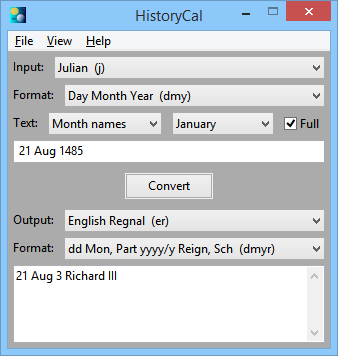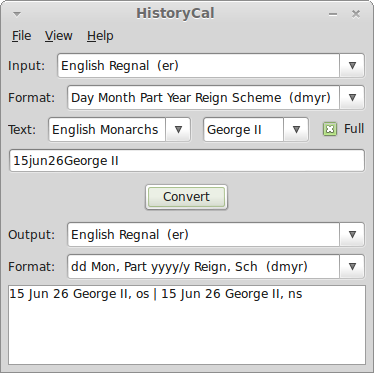Date Conversions

Converting dates between different calendars is one of HistoryCals most important uses. This is because HistoryCal handles (or rather, will handle) so many different calendars and calendar types.
Select the input calendar from the Input control. Select the input format from the next drop-down list. Then type in the date you want to convert. Select the output calendar from the Output control and the output format from the drop-down list. The converted date should then be shown in the bottom panel.
If you want to change the input date, edit the input text and press the Convert button.
Input Text
When you select the input format, this will show you which date elements (like the week day as well as the day, month and year) to enter and the expected order. So, for the current Gregorian calendar the choices are:
- Day Month Year (dmy)
- Month Day Year (mdy)
- WDay Day Month Year (wdmy)
- Year Month Day (ymd)
The letters in brackets are simply shorthand codes we can use to identify the format, we can ignore them for now.
Some elements of the date are written in numbers and some in text, and some may be written in either. When writing numbers, you can use either a space or a comma (or both) to separate them. You must use a comma to separate two text elements (since the space may be part of the text - as in "Richard III"). You do not need anything to separate a number and text. Also for entering text, case is not significant and any spaces may be omitted. Text normally has a full or abbreviated form as well as possible alternatives. Any may be used for input, but it must be one or the other.
A comment may be added to a date by enclosing it between square brackets. For example "18 Jun 1867 [John's birthday]". These comments will be ignored.
Input Keyword
The keyword "today" can be used as a date. The output will be the current date, according to the underlying operating system.
Output Text
In the current version of HistoryCal, the options are limited to selecting one of the pre-defined output formats. Future versions will allow the user to create their own style.
There are two distinct type of output format, reversible and non-reversible. By reversible we mean that if you feed the output back into the input control (with the correct setting, naturally) then the system will be able to read it and convert it back into its original form. It should do this without any errors. Currently, all the built-in output formats are reversible. If you want to use the date later as part of a calculation then you should always use a reversible output.
In a future version, it will be possible for the user to create or modify the output format and creating a non-reversible format will be possible. This will allow much more flexibility in creating outputs suitable for inserting into reports, say.

Some Surprises
Normally it really is this simple, but occasionally things get more interesting. For instance, if you want to convert the English Regnal date 15th June in the 26th year of the reign of George II to the Gregorian calendar, you may (or may not) be surprised to get two dates as an answer. This is because King George II started his reign on 11th June 1727 so the regnal year 26 started the 11th June 1752. In September of that year 11 days (3rd to 13th incl.) were removed when the calendar was changed from Julian to Gregorian. In order to keep the number of days at 365, the same as any other common year, 11 day were added to the end of the regnal year, and so the 27th year of his reign started 22nd June 1753.
So in King George II's 26th year, the days 3 Sep to 13 Sep are missing and the days 11 Jun to 21 Jun are repeated. If you enter "15 Jun 26 George II" with the calculator set to English Regnal, the output will be: "15 Jun 26 George II, os | 15 Jun 26 George II, ns". The significance of the '|' (vertical bar) will be detailed later in this manual, but for the moment we can simply read it as "or". Notice that for George II' regnal years the output always adds a "os" or "ns" (for Old Style or New Style). We do not normally need to include this in our input date because the calculator can work it out for its self. On the few occasions the it can't, as in our example, we can add it to input text and it then converts it to a single date.
Intermediate Value
HistoryCal works by first converting the input into a standard form - the Julian Day Number or jdn. (see Julian Day Number for a full description.) This number is then used to convert to the output form.
If you are interested, you can see this intermediate form, select the "Show Intermediate" option from the View menu. An additional output control will appear with the jdn value.
